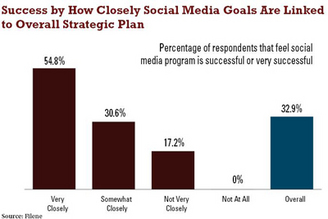When you hear the term “marketing mix”, what do you think…? Pause! Think… Pause!
Does that sound familiar to you? For some of you it might. To others it blurs as they follow the hypes as new marketing topics that are shouting at them. Or did you listen to their silent tones? Isn’t it better to varify and understand the client before start creating a new marketing-mix.
Watching the latest videos on your Youtube channel, talking to “friends” on Facebook or following the latest conversations on Twitter is one thing. Drawing conclusions out of these conversations on the social web world is another. And taking actions like evaluating adwords versus email versus social network marketing or blogs versus micro-blogs) for your marketing mix afterwards is a third step.
Conclusions might also be that marketers realize that B2B people still read print preferably to online or love real face-to-face conversations. They might find out that these business decision makers think twice before they engage in conversations. Reasons might be social media guidelines or policies. Steps are needed (like social media monitoring) before you start understanding your own marketing mix could pay out (i.e. online and offline focus groups).
Other marketing opportunities have never died although social media still hypes. And there is a reason why the “marketing mix” phrase was created by Neil Borden some years ago. Not only as it is an easy to understand phrase. More as we use it in our daily business as marketers without even noticing anymore. It is in our DNA. It is a necessity. Will it ever be removed? I doubt it…
Isn’t it interesting that we never had something like “The ultimate approach to market your products and services”?
Obviously, there is none. In over 50 years nobody found one. Why that is? Well, the world is driven by human beings and their attitudes to become familiar and aware of new things is a dynamic process. Some people adapt quick, other slower. They prefer to get informed via paper. Some like online (via publisher platforms, social networks or blogs). Some still stay offline (as they are often on planes or trains). Others record TV news programs and watch them on-demand with their iPads. And then others use mobile readers or apps to stay up to date with their favorite brands.
Seeing the social hypes in our business world from an outside perspective, I sometimes get the feeling that marketers have to refocus on where users are in their “adaption of technology evolution”. And not invest all their money in one horse race. Or to use another business anology from a tactical HR point of view: Never let the whole sales team be on the same flight.
Where is the difference in marketing?
Is there one? If all your marketing budget goes on airport billboards and then an oil crisis comes up, the invest equals zero in terms of earn out. Or if you buy just one ad in a service provider catalogue on the web but the world uses Google and cannot find the provider in the first ten results, the budget might be wasted.
Some companies think investing in Twitter or Facebook saves their brands awareness in the future but forget that these sites go down once in a while. And then the data is gone or not accessible. Lucky are those who can be approached from other access points then – be it via a phone call (at most companies I am searching hours for a phone number), at an event promoted with social media maybe, at their corporate website, or the self-hosted community that is not on the popular social networks.
The cocktail of having different access points available, and those interacting with each other, is the marketing mix of the future. Although they might have a single target or focus the are aiming at, the marketing mix should be aligned to one common strategy: Engage the client.
Spot on!
As we are automizing our marketing more and more, we always have to keep an eye open which tools and trends are coming up. As technology evolves quite quickly, human beings tend to forget that they need to adapt their marketing mix accordingly. Having said that it does not mean they have to switch their marketing mix approach immediately. Watch out for the tipping point when your power buyers, your brand vangelists, start using different technology. This is the time when the “adaption of technology evolution” happens…



 Marketers see many studies like one of the Morgan Stanley reports which state that there are more social network users than email users. And especially in the B2B sphere the research makes clear that 80% of business buyers today say that they find their vendors as opposed to vendors finding them.
Marketers see many studies like one of the Morgan Stanley reports which state that there are more social network users than email users. And especially in the B2B sphere the research makes clear that 80% of business buyers today say that they find their vendors as opposed to vendors finding them.  According to the study, companies using Social Media with more than two years of experience are the most likely to report success (57%), while those that have three months or less are least likely (17%).
According to the study, companies using Social Media with more than two years of experience are the most likely to report success (57%), while those that have three months or less are least likely (17%).
 One thing leads to another. Today we could transfer this quote to: One search leads to another social activity, and vice versa. And this interconnection of web-strategy tactics amplifies the user’s purchase decisions.
One thing leads to another. Today we could transfer this quote to: One search leads to another social activity, and vice versa. And this interconnection of web-strategy tactics amplifies the user’s purchase decisions.